#Anuttarayoga Tantra
Explore tagged Tumblr posts
Text


Tantra is the science of transforming ordinary lovers into soul mates. And that is the grandeur of Tantra. It can transform the whole earth; it can transform each couple into soul mates. -Rajneesh
Yab-Yum Talon Abraxas
Yab-Yum (Tibetan meaning "father-mother") is a common symbol in the Buddhist art of India, Bhutan, Nepal and Tibet representing the male deity in sexual union with his female consort. Often the male deity is sitting in lotus position while his consort is sitting in his lap.
The symbolism is associated with Anuttarayoga tantra and, while there are various interpretations of the symbolism in the twilight language, the male figure is usually linked to compassion (karuṇā) and skillful means (upāya-kauśalya), while the female partner to 'insight' (prajñā).
The symbolism of union and sexual polarity is a central teaching Tantric Buddhism, especially in Tibet. The union is realised by the practitioner as a mystical experience within one's own body.
Yab-yum is generally understood to represent the primordial (or mystical) union of wisdom and compassion. In Buddhism the masculine form is active, representing the compassion and skillful means (upaya) that have to be developed in order to reach enlightenment. The feminine form is passive and represents wisdom (prajna), which is also necessary to enlightenment. United, the figures symbolize the union necessary to overcome the veils of Maya, the false duality of object and subject.
Yab-yum may also be represented through the aniconic signification of yantra and mandala. In Tibetan Buddhism, the same ideas are to be found concerning the bell and the dorje, which, like the yab-yum, symbolize the dualism that must be exceeded. The sacred Tantric practice leads to rapid development of mind by using the experience of bliss, non-duality, andecstasy while in communion with one's consort.
119 notes
·
View notes
Text
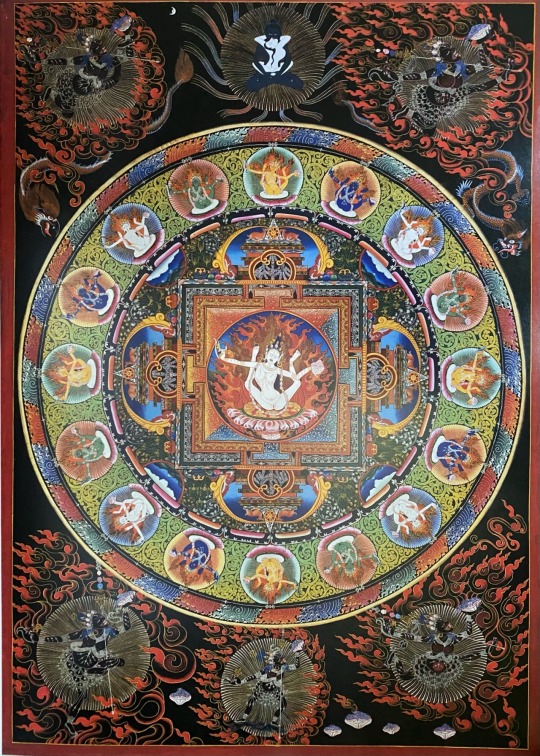
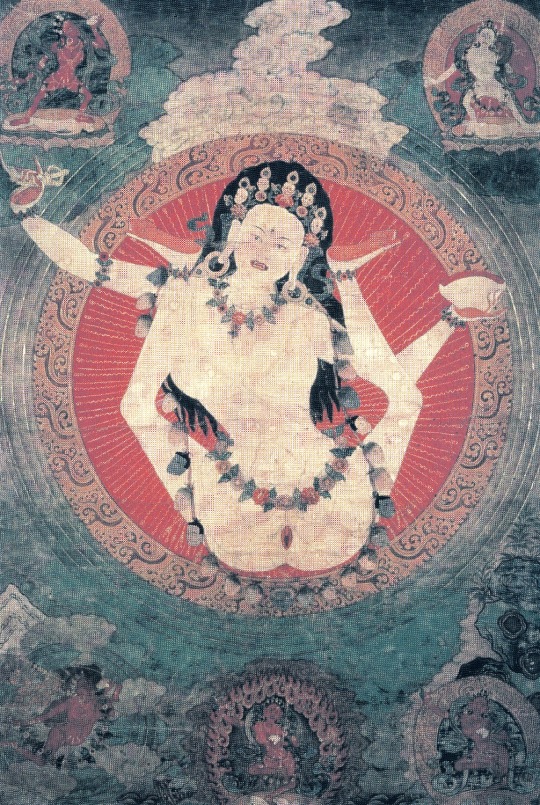
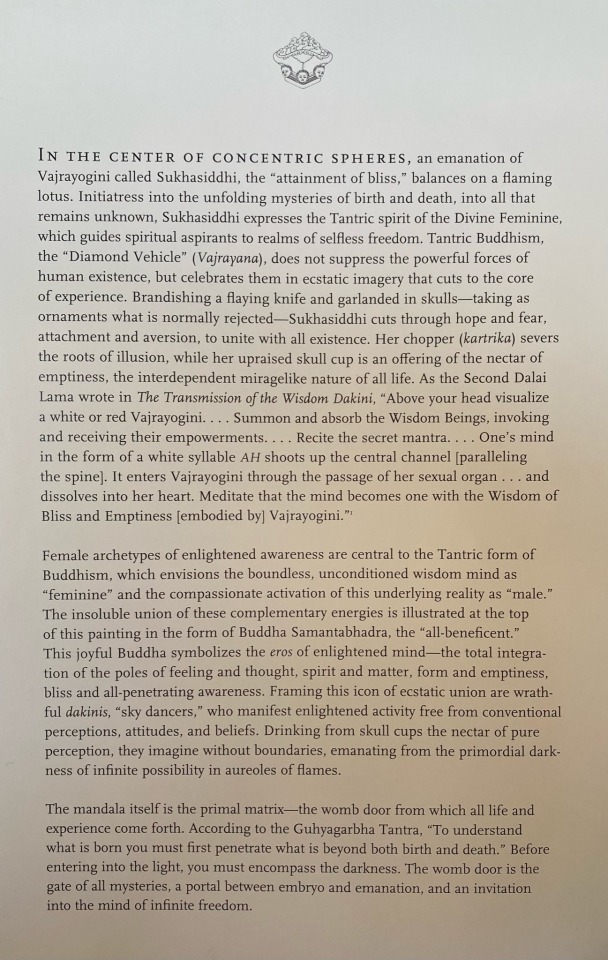
“Dakini Mandala: Gateway to Celestial Bliss” by Romio Shrestha, with text by Ian A. Baker.
From “Celestial Gallery” (2000).
Central image: Sukhasiddhi Dakini
Vajrayogini, is a representation of complete Buddhahood in female form, whose practices are associated with the Chakrasamvara Cycle of Anuttarayoga Tantra.
30 notes
·
View notes
Text

Ratnasambhava, Buddha a principal buddha within Vajrayana Buddhism representing the qualities of enlightenment and residing in the southern quarter of a mandala.
Ratnasambhava is primarily associated with Vajrayana Buddhism and originates in the Tantric Literature of the Yoga and Anuttarayoga Tantra classes. He is most commonly depicted in the set of the Five Symbolic Buddha's.
#buddha#buddhist#buddhism#dharma#sangha#mahayana#zen#milarepa#tibetan buddhism#thich nhat hanh#amitaba buddha#pure land#vajrayana
15 notes
·
View notes
Text

Kurukulla has a standard recognized appearance that is very common along with other forms that are less well known. There are numerous forms and lineages of Kurukulla arising from the Kriya and Anuttarayoga classes of Buddhist tantra of the New (Sarma) traditions and many forms from the 'Terma' (Revealed Treasure) discoveries of the Nyingmapa Tradition. She can appear peaceful or semi wrathful and in a range of colours from white, pink and blue to her more typical red colour. In the Kriya tantras she is often portrayed, but not exclusively, as a red power emanation of Tara. .
.
.
.
.
.
#lamathankapaintingschool #bhaktapurdurbarsquare #buddhism #sarma #tradition #tantra #wrathful #peaceful #tara #kurkulla #himalayan #art #thankapainting #redtara #sacred #heritage #livingheritage
19 notes
·
View notes
Text
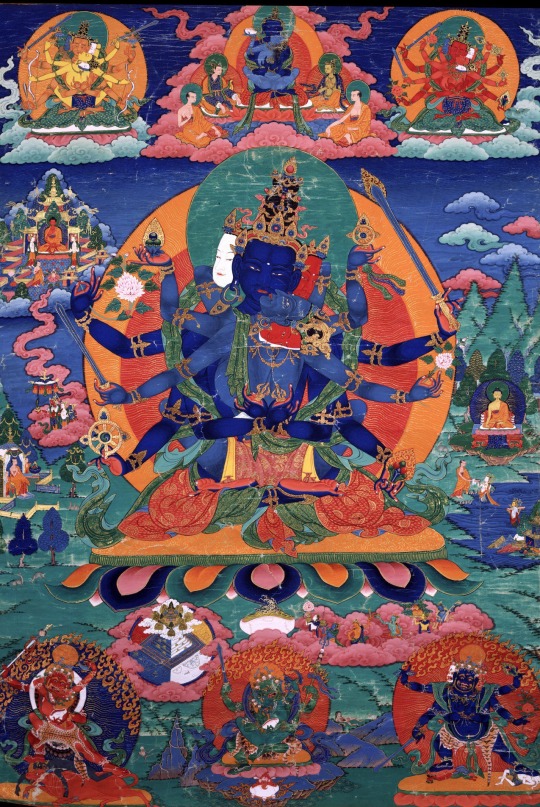
Guhyasamāja Tantra (Part LVI)
Guhyasamja is one of Vajrayana Buddhism’s most fascinating, difficult, and essential personalities. It combines various important tathagata Buddhas, into one image. He is most commonly called Akshobhayavajara which is the form of Akshobhaya buddha.
Guhyasamāja holds a significant position in Tibetan Buddhism as one of the most important deities within the Vajrayana tradition. The word "Guhyasamāja" can be translated as "secret assembly" or "mystic unity." This complex and profound deity embodies the union of wisdom and compassion, embodying the ultimate goal of spiritual awakening.
Guhyasamāja has its roots in ancient Indian Buddhist Tantra, particularly within the broader framework of the Mahayana and Vajrayana traditions. It is believed to have been transmitted to Tibet by the great Indian master Padmasambhava in the 8th century CE. The deity is often depicted in a yab-yum (Tibetan for "father-mother") posture, symbolizing the union of wisdom (represented by the male deity) and compassion (represented by the female deity). Guhyasamāja is portrayed as a transcendent being with multiple heads and arms, adorned with various ornaments, and seated on a lotus throne.
The iconography of Guhyasamāja carries profound symbolism that reflects the core principles of Tibetan Buddhism. The multiple heads and arms represent the deity's enlightened qualities and ability to manifest in various forms to assist sentient beings. The yab-yum posture signifies the non-dualistic nature of reality, where wisdom and compassion are inseparable. Guhyasamāja embodies the union of bliss and emptiness, representing the ultimate state of enlightenment, often referred to as the union of method and wisdom.
The practice of Guhyasamāja is highly esoteric and advanced, primarily undertaken by experienced practitioners under the guidance of qualified teachers. The primary aim of these practices is to transform ordinary experiences into the path of awakening. The empowerment or initiation into the Guhyasamāja practice is a crucial step for practitioners, allowing them to establish a direct connection with the deity's enlightened qualities. Empowerments involve rituals, visualization, mantra recitation, and the cultivation of meditative absorption.
Meditation is an essential component of Guhyasamāja practice. Tibetan Buddhist practitioners engage in various meditation techniques associated with this deity to purify their minds and cultivate wisdom and compassion. One such method is deity yoga, where practitioners visualize themselves as Guhyasamāja, embodying the enlightened qualities of the deity. Through this practice, one aims to dissolve the dualistic perception of self and other, cultivating a deep sense of interconnectedness and compassion.
Tantric rituals play a significant role in Guhyasamāja practice. These rituals involve elaborate ceremonies, including chanting of mantras, visualization, mudras (hand gestures), and the offering of various substances such as flowers, incense, and symbolic offerings. These rituals are performed to invoke the presence of Guhyasamāja and to purify and transform mundane experiences into the path of enlightenment.
Guhyasamāja holds a central position in the Vajrayana tradition of Tibetan Buddhism. The practice of Guhyasamāja is considered an advanced practice.
Guhyasamja is the foremost meditational deity of the Method-father class of Anuttarayoga tantra. Guhyasamaja has two main traditions, the Arya (Nagarjuna) Lineage, and the Jnana (Jnanapada) Lineage.
In general there are three principal iconographic forms of Guhyasamaja within this tradition.
Akshobhyavajra (blue),
Manjuvajra (orange), and
Avalokita (red).
All three of these forms have three faces, six arms, two legs, and embrace a consort. Guhyasamaja can appear as either peaceful or slightly peaceful and slightly wrathful.
Guhyasamāja is blue-black in color, a form of Akshobhya, one of the five transcendent lords. Akshobhyavajra holds a vajra and bell in his first two hands, and other hands hold the symbols of the four other transcendent lords, wheel of Vairocana, and lotus of Amitabha in his right. and the gem of Ratnasambhava and sword of Amoghasiddhi in his left.
The sadana continues:
BLESSING THE BODY, SPEECH, AND MIND JOINTLY
"I become the great Vajradhara in whom all the tathāgatas' three vajras of body, speech, and mind combined inseparably.
Om sarvatathāgatakāyavākcittav ajrasvabhāvātmako 'ham".
The sadhana recitation for this practice is limited to this brief statement. Lineage lamas have described the visualization that relates to it in the following manner. Among the thirty-two deities installed in your body, twenty-three are male deities, namely, the five lineage tathāgatas, the eight bodhisattvas, and the ten wrathful deities. Similarly, nine are female deities-that is, the four divine consorts and the five sense goddesses. Each of the twenty-three male deities emanates countless duplicates of himself who invite countless forms of one of the nine goddesses. Similarly, the four consorts and the five sense goddesses emanate countless duplicates of themselves who invite countless forms of each of the twenty-three male deities, with each goddess inviting the male deities who correspond to their respective lineage.
Thus, while appearing in Vajrasattva's emanation-body form, visualize that each of the body mandala's thirty-two male and female deities emanates countless duplicates of himself or herself, that fill the entirety of space. Each of these multitudes of emanations then invites countless forms of their counterpart female or male deity. After embracing one another, these countless pairs of deities dissolve into one another until they become single pairs of each of the thirty-two deities who position themselves in the space above the circular beam inside the mandala palace, then visualize that you emanate a duplicate of yourself who comes before this assembly of deity pairs and makes a supplication to them. Following this supplication, the deity pairs enter into sexual union
and dissolve into thirty-two portions of a
luminous substance whose essence is bliss-voidness wisdom. These substances dissolve into the corresponding thirty-two body-mandala deities, filling their bodies. The surplus of these substances spill out from the bodies of the body-mandala deities and fill your main body that is appearing in Vajrasattva's form. As this occurs, reflect that you attain the status of the great Vajradhara in whom all the tathāgatas' three vajras of body, speech, and mind are combined inseparably. Then recite the mantra for generating the divine pride in which you reflect, "I am the one whose nature is composed of the body, speech, and mind vajras of all the tathāgatas."
7 notes
·
View notes
Photo
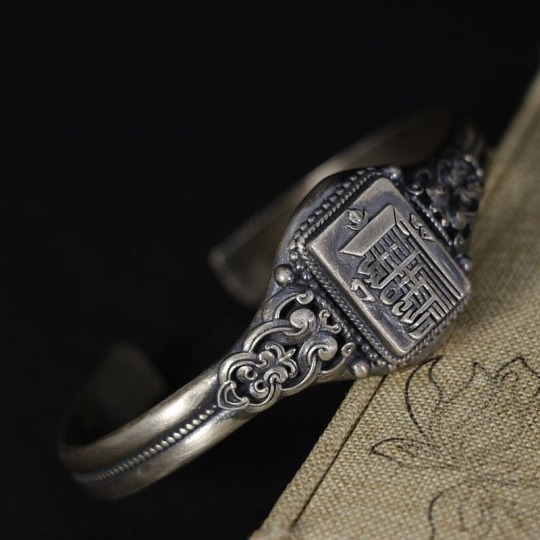
The Kalachakra means "Wheel of Time" in Sanskrit. The Kalachakra is an elaborate explanation of the creation of all matter. It aims to explain that humans are not separate from the universe. But both the universe and human. It is a detailed map of the the inner world (the entire universe) and the outer world (the shell of the universe). And if fully understood and used in the practice of meditation can bring supreme happiness. . 925 Sterling silver Kalachakra cuff-bracelet. . Website link is in the bio. @mantrapiece . #mantrapiece #kalachakra #kalachakramandala #kalachakratemple #kalachakrathangka #tibetanbuddhism #vajrayana #vajrayanabuddhism #vajrayāna #vajrayanabuddhist #vajrayanaart #budismovajrayana #tantra #tantrayoga #tantrayana #tantralife #tantrameditation #mahayana #mahayanabuddhism #sanskrit #buddhahood #wheeloftime #shaivism #vaishnavism #samkhya #madhyamaka #cosmology #kalacakra #anuttara #anuttarayoga (at Los Angeles, California) https://www.instagram.com/p/Ce1tq_kv_4B/?igshid=NGJjMDIxMWI=
#mantrapiece#kalachakra#kalachakramandala#kalachakratemple#kalachakrathangka#tibetanbuddhism#vajrayana#vajrayanabuddhism#vajrayāna#vajrayanabuddhist#vajrayanaart#budismovajrayana#tantra#tantrayoga#tantrayana#tantralife#tantrameditation#mahayana#mahayanabuddhism#sanskrit#buddhahood#wheeloftime#shaivism#vaishnavism#samkhya#madhyamaka#cosmology#kalacakra#anuttara#anuttarayoga
2 notes
·
View notes
Photo

Chakrasamvara and Consort ca 17th century. Tibet. Mineral pigments with gold on cloth. Chakrasamvara, which translates to "wheel of bliss," is one of the most popular yidam (meditations deity) in Tantric Buddhism after the 11th century. As the principal deities of the Anuttarayoga Tantra of the Vajrayana Buddhist tradition, Chakrasamvara can appear in several dozen different forms, from simple to complex, peaceful to wrathful. Here, Chakrasamvara and his consort Vajravarahi are both shown in wrathful form, standing over Kalaratri and Black Bhairava, symbolizing triumph over ego and ignorance. (via Instagram: Kapoor Galleries)
235 notes
·
View notes
Text
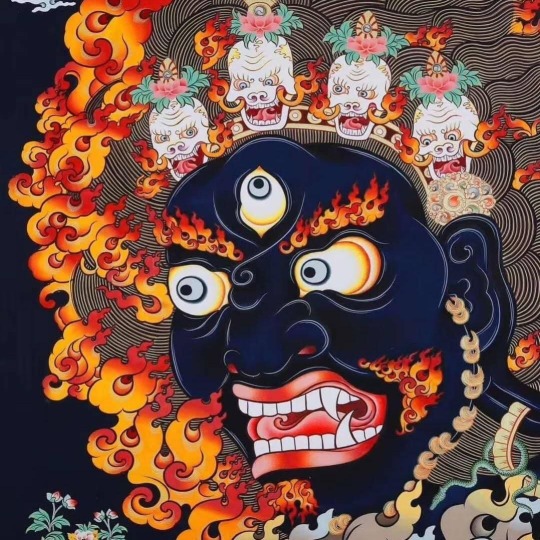
Mahakala (Sanskrit: Mahākāla) is a Dharmapala ("protector of Dharma") in Vajrayana Buddhism (Tibetan, Nepalese Newar, Chinese, Japanese Shingon traditions and related). In Chinese and Japanese Buddhism tradition is known as Daheitian or Daikokuten (大黒天).
Mahakala is a category of Tantric Buddhist deity. His primary function is as a protector (Dharmapala) and specifically the primary Wisdom Protector of Tantric Buddhism - Vajrayana. There are dozens of different variations and forms of Mahakala. He is typically in wrathful appearance following the Indian model of a Raksha demon. In most occurrences and uses of Mahakala, he is paired with a meditational deity such as Panjarnata Mahakala and Shri Hevajra, Chaturbhuja Mahakala and Chakrasamvara, Chaturmukha Mahakala and Guhyasamaja. In most cases Mahakala is an emanation, or wrathful aspect, of the principal meditational deity that he is associated with. For instance Panjarnata Mahakala is the most wrathful emanation, or form, of Hevajra. In other situations Mahakala might be a wrathful emanation of Vajradhara or Akshobhya Buddha. Aside from the individual Anuttarayoga Tantras that teach various forms of Mahakala, the principal texts are the Twenty-five and Fifty Chapter Mahakala Tantra.
In one specific case, Shadbhuja Mahakala, Avalokiteshvara takes on the form of Mahakala. Therefore, it can be said that the Shadbhuja form, with one face and six hands, arising from the Eight Chapter Mahakala Tantra, is a wrathful Avalokiteshvara.
http://en.wikipedia.org/wiki/Mahakala
50 notes
·
View notes
Text
Vajrayogini Up Date
Vajrayoginī
(Sanskrit: Vajrayoginī; Tibetan: རྡོ་རྗེ་རྣལ་འབྱོར་མ་, Dorjé Naljorma) is a Tantric Buddhist female Buddha and a Dākiṇī.
Vajrayoginī's essence is "great passion" (maharaga), a transcendent passion that is free of selfishness and illusion — she intensely works for the well-being of others and for the destruction of ego clinging. She is seen as being ideally suited for people with strong passions, providing the way to transform those passions into enlightened virtues.
She is an Anuttarayoga Tantra iṣṭadevatā (meditation deity) and her practice includes methods for preventing ordinary death, intermediate state (bardo) and rebirth (by transforming them into paths to enlightenment), and for transforming all mundane daily experiences into higher spiritual paths.
Practices associated with her are Chöd and the Six Yogas of Naropa.
Vajrayoginī is often described with the epithet sarvabuddhaḍākiṇī, meaning "the ḍākiṇī [who is the Essence] of all Buddhas"
Origin and Lineage
Vajrayoginī's sādhanā originated in the Himalayan region between the tenth and twelfth centuries. It evolved from the Cakrasaṃvara Tantra, where Vajrayoginī appears as his Yab-Yum consort, to become a stand-alone practice of Anuttarayoga Tantra in its own right. The practice of Vajrayoginī belongs to the Mother Tantra (Wylie: ma rgyud) class of Anuttarayoga Tantras along with other tantras such as the Cakrasaṃvara and Hevajra Tantras.
Vajrayana teaches that the two stages of the practice of Vajrayoginī (generation stage and completion stage) were originally taught by Vajradhara. He manifested in the form of Heruka to expound the Root Tantra of Chakrasaṃvara, and it was in this tantra that he explained the practice of Vajrayoginī. All the many lineages of instructions on Vajrayoginī can be traced back to this original revelation. Of these lineages, there are three that are most commonly practiced: the Narokhachö lineage, which was transmitted from Vajrayoginī to Naropa; the Maitrikhachö lineage, which was transmitted from Vajrayoginī to Maitripa; and the Indrakhachö lineage, which was transmitted from Vajrayoginī to Indrabodhi.
Vajrayoginī is visualized as the translucent, deep red form of a 16-year-old female with the third eye of wisdom set vertically on her forehead and unbound flowing hair. Vajrayoginī is generally depicted with the traditional accoutrements of a ḍākiṇī, including a kartika (a vajra-handled flaying knife) in her right hand and a kapala filled with blood in her left hand that she drinks from with upturned mouth.
Her consort Cakrasaṃvara is often symbolically depicted as a khaṭvāṅga on Vajrayoginī's left shoulder, when she is in "solitary hero" form. Vajrayoginī's khaṭvāṅga is marked with a vajra and from it hangs a damaru drum, a bell, and a triple banner. Her extended right leg treads on the chest of red Kālarātri, while her bent left leg treads on the forehead of black Bhairava, bending his head backward and pressing it into his back at the level of his heart. Her head is adorned with a crown of five human skulls and she wears a necklace of fifty human skulls. She is depicted as standing in the center of a blazing fire of exalted wisdom. Her countenance shows both erotic and fierce features, "in the fullness of bliss, laughing and baring her fangs."
Each aspect of Vajrayoginī's form and mandala is designed to convey a spiritual meaning. For example, her brilliant red-colored body symbolizes the blazing of her tummo (candali) or "inner fire" of spiritual transformation as well as life force (Shakti), blood of birth and menstrual blood. Her single face symbolizes that she has realized that all phenomena are of one nature in emptiness. Her two arms symbolize her realization of the two truths. Her three eyes symbolize her ability to see everything in the past, present and future. She looks upward toward the Pure Dākiṇī Land, demonstrating her attainment of outer and inner Pure Dākiṇī Land, and indicating that she leads her followers to these attainments. The curved driguk knife in her right hand shows her power to cut the continuum of the delusions and obstacles of her followers and of all living beings. Drinking the blood from the kapala in her left hand symbolizes her experience of the clear light of bliss.
Vajravarahi and Other Forms
Vajrayoginī is a female deity and although she is sometimes visualized as simply Vajrayoginī, in a collection of her sādhanās she is visualized in an alternate form in over two thirds of the practices. Her other forms include Vajravārāhī (Wylie: rdo-rje phag-mo "Vajra Sow") and Krodikali (alt. Krodhakali, Kālikā, Krodheśvarī, Krishna Krodhini, Tibetan Tröma Nakmo; Wylie: khros ma nag mo, "Wrathful Lady", "Fierce Black One").
In her form as Vajravārāhī "the Vajra Sow", she is often pictured with a sow's head on the side of her own as an ornament and in one form has the head of a sow herself. Vajrayoginī is often associated with triumph over ignorance, the pig being associated with ignorance in Buddhism. This sow head relates to the origins of Vajravārāhī from the Hindu sow-faced goddess Vārāhī.
The severed-headed form of Vajrayoginī is similar to the Indian goddess Chinnamasta, who is recognized by both Hindus and Buddhists.
A white manifestation, generally designated as Prajñaloka, “Light of Wisdom ,” displays a vajra and a skull bowl.
Practices
Vajrayoginī acts as a meditation deity, or the yab-yum consort of such a deity, in Vajrayāna Buddhism. She appears in a maṇḍala that is visualized by the practitioner according to a sādhana describing the practice of the particular tantra. There are several collections containing sādhanas associated with Vajrayoginī including one collection, the Guhyasamayasādhanamālā, containing only Vajrayoginī sādhanas and comprising forty-six works by various authors.
The yidam that a meditator identifies with when practicing the Six Yogas of Nāropa is Vajrayoginī and she is an important deity for tantric initiation, especially for new initiates as Vajrayoginī's practice is said to be well-suited to those with strong desirous attachment, and to those living in the current "degenerate age".
As Vajravārāhī, her consort is Chakrasaṃvara (Tib. Khorlo Demchog), who is often depicted symbolically as a khaṭvāṇga on her left shoulder. In this form she is also the consort of Jinasagara (Tib. Gyalwa Gyatso), the red Avalokiteśvara (Tib. Chenrezig).
Vajrayoginī is a key figure in the advanced Tibetan Buddhist practice of Chöd, where she appears in her Kālikā (Standard Tibetan: Khros ma nag mo) or Vajravārāhī (Tibetan:rDo rje phag mo) forms.
Vajrayoginī also appears in versions of Guru yoga in the Kagyu school of Tibetan Buddhism.
In one popular system the practitioner worships their guru in the form of Milarepa, whilst visualizing themself as Vajrayoginī.
The purpose of visualizing Vajrayoginī is to gain realizations of generation stage tantra, in which the practitioner mentally visualises themself as their yidam or meditational deity and their surroundings as the Deity's maṇḍala.
The purpose of generation stage is to overcome so-called ordinary appearances and ordinary conceptions, which are said in Vajrayana Buddhism to be the obstructions to liberation (Skt. nirvāṇa) and enlightenment.
According to most commentaries associated with the deity, the practices of Vajrayoginī are relatively easy compared to those of other Highest Yoga Tantra yidams and particularly suited to practitioners in modern times:....
The instructions on the practice of Vajrayoginī contain concise and clearly presented meditations that are relatively easy to practice. The mantra is short and easy to recite, and the visualizations of the maṇḍala, the Deity, and the body maṇḍala are simple compared with those of other Highest Yoga Tantra Deities.
Even practitioners with limited abilities and little wisdom can engage in these practices without great difficulty. The practice of Vajrayoginī quickly brings blessings, especially during this spiritually degenerate age. It is said that as the general level of spirituality decreases, it becomes increasingly difficult for practitioners to receive the blessings of other Deities; but the opposite is the case with Heruka and Vajrayoginī – the more times degenerate, the more easily practitioners can receive their blessings.
Thanks to Wiki Sources
The Sacred Image of Vajrayogini was made by the Donogal family in the ancient Patan district of Kathmandu, home of the finest sacred statue makers in the world. HH Vajrayogini stands approx 5 ft in height and occupies a prominent space in our community’s Three Year Retreat meditation hall.

21 notes
·
View notes
Photo

exoticindia.com
Standing Mahakala (Tibetan Buddhist)
Mahakala (Great Black One) is a category of male Tantric Buddhist deities. The common function of Mahakala is as a protector (Dharmapala) deity and specifically the primary Wisdom Protector of Himalayan and Tibetan Buddhism. In some cases, Mahakala can also be a meditational deity (ishtadevata) in the highest Anuttarayoga Tantras. For the study of Mahakala there are three important topics: Principal Texts, Principal Systems and Principal Iconographic Forms.
#buddhist art#zen art#tibetan buddhism#tibetan art#buddhist#buddha#buddhism#lord buddha#buddhist deities
3 notes
·
View notes
Text

CHAKRASAMVARA
RudraAsianArt.etsy.com
Chakrasamvara embracing his yogini consort Vajravarahi is a highly energized visualization of key deities in the Vajrayana system of Tibetan Buddhism. They unite two of the most powerful ideas in esoteric Buddhism-- wisdom, embodied in Vajravarahi, and compassion, the essence of Chakrasamvara. His name, which translates as “Circle of Bliss”, embodies the powerful union of these two fundamentals tenets of Buddhism.
The Chakrasamvara Tantra (Tibetan: khor lo dem chog. English: The Wheel of Bliss) is the principal tantra of the Anuttarayoga Wisdom (mother) classification of the Vajrayana Buddhist Tradition. Chakrasamvara is one of the most popular deities in Tantric Buddhism in the Himalayan regions and Tibet after the 11th century. Samvara is one of the principal yidams or meditational deities of the Kadyu, Gelug and Sakya schools of Tibetan Buddhism. He can appear in several dozen different forms, from simple to complex and peaceful to wrathful. There are as many as fifty different Chakrasamvara traditions in Tibetan Buddhism. The three most famous traditions are those of Luipa, Krishnacharin and Ghantapa followed by Maitrpa, Mitra Yogin, and Abhakara Gupta.
THE DEITY CHAKRASAMVARA—NAME AND MYTHS
The central deity of the tradition is called Samvara, Śamvara, Śrī Heruka, or simply Heruka. This figure became popular in Buddhist circles around the 8th century. The noun samvara derives from a verb which means to "bind," "enclose," or "conceal," and samvara commonly means "vow" and sometimes "sanctuary". In the Chakrasamvara tantra text it appears in various compounds, such as "the binding of the dakini net" (ḍākinījālasamvara), which is associated with the term "union with Śrī Heruka." In this sense, samvara can also refer to "union", which is supreme bliss and supreme awakening the adept visualizes the three wheels of the mandala within his/her own body."
Regarding the name Heruka, it first appears as a name for a class of fierce demon like beings. Heruka also appears as a charnel ground deity which is said to be "the guise assumed by the Buddha Vajradhara in his effort to subdue evil doers," in the Samayoga Tantra. In the Samayoga, the universe is being destroyed by evil beings (stirred up by Mara), and all the Hindu deities seek refuge in Vajradhara, who assembles all the Buddhas. Since these evil beings are not able to be subdued by peaceful means, the Buddhas must manifest ferocious appearances. Heruka is born from Vajradhara, and he burns up the entire universe, purifying it in the process.
THE DEITY CHAKRASAMVARA—ICONOGRAPHY
Samvara is typically depicted with a blue-colored body, four faces, and twelve arms, and embracing his consort, the wisdom dakini Vajravārāhī or Vajrayogni in Yab-Yum (sexual union). The deity is described by Jamyang Khyentse Wangpo (1820-1892). The Collected Works of the Great Jamyang Khyentse Wangpo, vol.7, fol.215-226. Gyud de Kun Tus, vol.25, folios 11-19. [Translated October 14, 1989]).:
"...Shri Chakrasamvara has a body blue in color, with four faces and twelve hands. The main face is blue, left face red, back face yellow and right face white. Each face has three eyes and four bared fangs. The first two hands hold a vajra and bell embracing the mother. The lower two hold an elephant skin out-stretched; third right a damaru, fourth an axe, fifth a trident, sixth a curved knife. The third left holds a katvanga marked with a vajra; fourth a vajra lasso, fifth a blood filled skullcup, sixth carries the four-faced head of Brahma. The right leg is straight and presses on the breast of red Kalaratri; left bent and pressing on the head of black Yama. The hair is tied in a topknot on the crown of the head; on the crest a wish-fulfilling jewel ornament and crescent moon. The soft spot at the top of the head is marked with a vishvavajra. Each head has a crown of five dry human skulls; a necklace of fifty fresh heads and six bone ornaments; wearing a lower garment of tiger skin; possessed of the nine emotions of dancing; grace, fearlessness and ugliness; laughter, ferocity and frightfulness; compassion, fury and peacefulness.
"In the lap is the Mother Vajravarahi, with a body red in color, one face, two hands and three eyes. The left holds a blood-filled skull cup embracing the Father and the right a curved knife in a threatening gesture pointed in all directions. The hair is worn piled on the head; a crown of five dry human skulls and fifty dry as a necklace. The left leg is straight and right bent, embracing the Father. Both Father-Mother stand in the middle of a blazing fire of pristine awareness."
Listen to the Gyoto monks chant praises to Chakrasamvara on YouTube
https://youtu.be/njpNKXsyA1k
🔸🔹🔶
Now available from RudraAsianArt.etsy.com, an exquisitely refined thangka painting of Chakrasamvara. The thangka is painted wall size in harmonious fiery colors with graceful lines, and fully expressing the passionate fierceness of the deity Samvara. Rendered in gauche colors with genuine 24K gold embellishments. Please don’t hesitate to message me with questions about mounting this extraordinary sacred art for your home or meditation space. Click the links and view all the detail photographs.
Find a piece of sacred art today to inspire you for a lifetime!
4 notes
·
View notes
Text

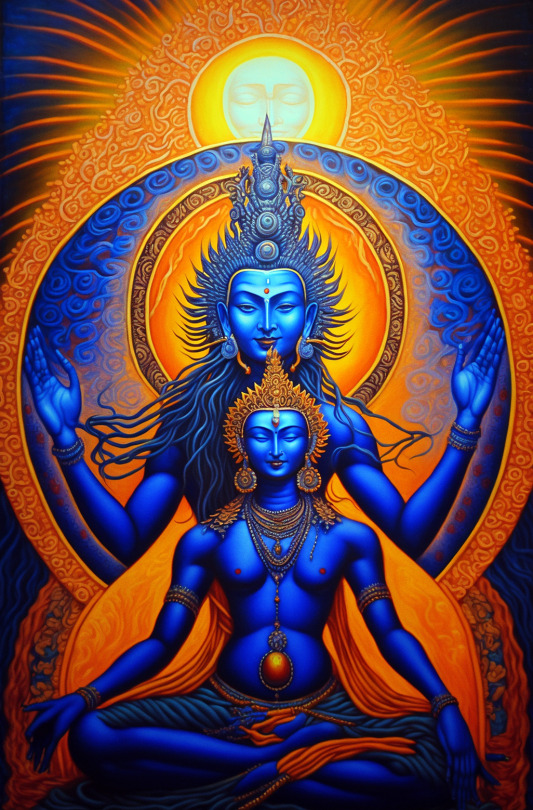
Yab-Yum Talon Abraxas
Yab-yum (Tibetan meaning "father-mother") is a common symbol in the Buddhist art of India, Bhutan, Nepal and Tibet representing the male deity in sexual union with his female consort. Often the male deity is sitting in lotus position while his consort is sitting in his lap.
The symbolism is associated with Anuttarayoga tantra and, while there are various interpretations of the symbolism in the twilight language, the male figure is usually linked to compassion (karuṇā) and skillful means (upāya-kauśalya), while the female partner to 'insight' (prajñā).
The symbolism of union and sexual polarity is a central teaching Tantric Buddhism, especially in Tibet. The union is realised by the practitioner as a mystical experience within one's own body.
81 notes
·
View notes
Text

Kurukulla has a standard recognized appearance that is very common along with other forms that are less well known. There are numerous forms and lineages of Kurukulla arising from the Kriya and Anuttarayoga classes of Buddhist tantra of the New (Sarma) traditions and many forms from the 'Terma' (Revealed Treasure) discoveries of the Nyingmapa Tradition. She can appear peaceful or semi wrathful and in a range of colours from white, pink and blue to her more typical red colour. In the Kriya tantras she is often portrayed, but not exclusively, as a red power emanation of Tara..
#buddha#buddhist#buddhism#dharma#sangha#mahayana#zen#milarepa#tibetan buddhism#thich nhat hanh#dakini
7 notes
·
View notes
Photo

Vajrayogini, is a representation of complete buddhahood in female form. Classified as Wisdom or 'Mother' Anuttarayoga Tantra the practices originate with the Chakrasamvara Cycle of Tantras. Although found in a variety of forms, she is common to all schools of Tibetan Buddhism. #lamathankapaintingschool #buddhism #dakine #vajrayogini #femalebuddha #wisdom #mother #Anuttarayoga #tantra #tibetanbuddhism (at LAMA THANKA PAINTING SCHOOL) https://www.instagram.com/p/CBdA3rlByBS/?igshid=t8xsp462ikta
#lamathankapaintingschool#buddhism#dakine#vajrayogini#femalebuddha#wisdom#mother#anuttarayoga#tantra#tibetanbuddhism
1 note
·
View note
Text
Buy Niue Legendary Lands: Shambhala Silver 2 oz Antique Coin Online

BOLD is happy to introduce Shambhala Silver 2 oz Antique Coin which shows a Hindu woman with the mystical Shambala above her. Features at the left is a stunning view of the Mahabodhi Temple, a Buddhist temple complex in northern India. To the right is depicted the Temple of Ranakpur Jain, located in Rajasthan.
About Shambhala
In the Tibetan Buddhist tradition, Shambhala also spelled Shambhala or Shamballa is a spiritual realm. Shambhala is mentioned in the Kalachakra Tantra. The Bon scriptures speak of a closely related land called the Tagzig Olmo Lung Ring.
The Sanskrit name is taken from the name of a city mentioned in the Hindu Puranas. The exact length of Shambhala is 245 yojanas (approximately) according to Vishnu Purana.
Shambhala is ruled by the future Maitreya Buddha. The Shambhala narrative is found in the Kalachakra Tantra, a text from the Anuttarayoga Tantras group. Kalachakra Buddhism was allegedly introduced to Tibet in the 11th century, the time of the Kalachakra Tibetan calendar. The oldest known Kalachakra masters are Dolpopa Sherab Gyaltsen (d. 1361) and Buton Rinchen Drub (d. 1364).
Some Interesting Fact:
For thousands of years, stories have been told of a mystical paradise called Shambhala. Hidden within the Himalayan Mountains, it has come to be known by many other names: Shangri-La, the Land of White Waters, the Forbidden Land, the Land of the Living Gods, the Land of Radiant Spirits, and the Land of Living Fire.
Shambhala has sparked the imagination and curiosity of many generations, religions, cultures, and nationalities, and those with adventurous natures have even attempted to search for the physical location of this paradise, which is said to be filled with wish-granting trees and transparent jewels. -like lakes.
The name Shambhala in Sanskrit means"place of peace/happiness" or "place of silence". It is considered a pure land within the Human Realm.
According to the Kalachakra Tantra scriptures, the first king of Shambhala, King Suchandra, asked Shakyamuni Buddha to grant him a practice that would not require him to give up his age-old responsibilities to rule his kingdom and people.
Why Should You Buy Shambhala Silver 2 oz Antique Coin From BOLD Precious Metals?
1: Unwavering Trustworthiness.
2: 24X7 Great Customer Service.
3: BOLD has a large unique Inventory.
4: Get the best price on every product.
0 notes
Video
instagram
Kalachakra cuff-bracelet. Only @mantrapiece . #mantrapiece #kalachakra #kalachakramandala #kalachakratemple #kalachakrathangka #tibetanbuddhism #vajrayana #vajrayanabuddhism #vajrayāna #vajrayanabuddhist #vajrayanaart #budismovajrayana #tantra #tantrayoga #tantrayana #tantralife #tantrameditation #mahayana #mahayanabuddhism #sanskrit #buddhahood #wheeloftime #shaivism #vaishnavism #samkhya #madhyamaka #cosmology #kalacakra #anuttara #anuttarayoga (at Los Angeles, California) https://www.instagram.com/p/CeZOmOjlfx1/?igshid=NGJjMDIxMWI=
#mantrapiece#kalachakra#kalachakramandala#kalachakratemple#kalachakrathangka#tibetanbuddhism#vajrayana#vajrayanabuddhism#vajrayāna#vajrayanabuddhist#vajrayanaart#budismovajrayana#tantra#tantrayoga#tantrayana#tantralife#tantrameditation#mahayana#mahayanabuddhism#sanskrit#buddhahood#wheeloftime#shaivism#vaishnavism#samkhya#madhyamaka#cosmology#kalacakra#anuttara#anuttarayoga
0 notes